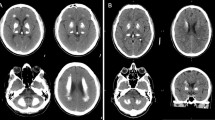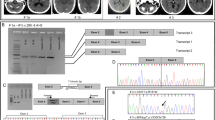Abstract
Primary familial brain calcification (PFBC), often called Fahr’s disease, is a condition in which calcium phosphate accumulates in the brain, mainly in the basal ganglia, thalamus, and cerebellum, and without the association of any metabolic or infectious cause. Patients present a variety of neurological and psychiatric disorders, usually during adulthood. The disease is caused by autosomal dominant pathogenic variants in genes such as SLC20A2, PDGFRB, PDGFB, and XPR1. MYORG and JAM2 are the other genes linked to homozygous patterns of inheritance. Here, we briefly discuss the recent cases reported by Ceylan et al. (2022) and Al-Kasbi et al. (2022), which challenge the current association with two previous genes and a clear pattern of inheritance. Ceylan et al. report a new biallelic variant related to a pathogenic variant in the SLC20A2 gene, which is typically associated with a heterozygous mutation pattern. The affected siblings displayed a severe and early onset of the disease, revealing a phenotype similar to that seen in CMV infections, often named as pseudo-TORCH. Furthermore, a study of genes related to intellectual disability conducted by Al-Kasbi et al. demonstrated that the biallelic manifestation of the XPR1 gene was associated with early symptoms, leading to the belief that the homozygous pattern of genes responsible for causing PFBC with an autosomal dominant pattern may also be linked to early-onset manifestations of PFBC. Further studies might explore the variety of clinical presentations linked to PFBC genes, especially if we pay attention to complex patterns of inheritance, reinforcing the need for a more detailed bioinformatic analysis.
Similar content being viewed by others
References
Al-Kasbi G, Al-Murshedi F, Al-Kindi A et al (2022) The diagnostic yield, candidate genes, and pitfalls for a genetic study of intellectual disability in 118 middle eastern families. Sci Rep 12:18862. https://doi.org/10.1038/s41598-022-22036-z
Aran A, Rosenfeld N, Jaron R, Renbaum P, Zuckerman S, Fridman H, Zeligson S, Segel R, Kohn Y, Kamal L, Kanaan M, Segev Y, Mazaki E, Rabinowitz R, Shen O, Lee M, Walsh T, King MC, Gulsuner S, Levy-Lahad E (2016) Loss of function of PCDH12 underlies recessive microcephaly mimicking intrauterine infection. Neurology 86(21):2016–2024. https://doi.org/10.1212/WNL.0000000000002704
Borges-Medeiros RL, de Oliveira JRM (2020) Digenic variants as possible clinical modifier of primary familial brain calcification patients. J Mol Neurosci 70(1):142–144. https://doi.org/10.1007/s12031-019-01430-9. Epub 2019 Nov 25 PMID: 31768941
Ceylan AC, Kireker Köylü O, Özyürek H, Özaydin E, Yön Mİ, Kasapkara ÇS (2022) Homozygous SLC20A2 mutations cause congenital CMV infection-like phenotype. Acta Neurol Belg. https://doi.org/10.1007/s13760-022-02044-6
Da Silva RJG, Pereira ICL, Oliveira JRM (2013) Analysis of gene expression pattern and neuroanatomical correlates for SLC20A2 (PiT-2) shows a molecular network with potential impact in idiopathic basal ganglia calcification (“Fahr’s disease”). J Mol Neurosci 50:280–283. https://doi.org/10.1007/s12031-013-0001-0
Meuwissen ME, Schot R, Buta S, Oudesluijs G, Tinschert S, Speer SD, Li Z, van Unen L, Heijsman D, Goldmann T, Lequin MH, Kros JM, Stam W, Hermann M, Willemsen R, Brouwer RW, Van IJcken WF, Martin-Fernandez M, de Coo I, Dudink J, de Vries FA, Bertoli Avella A, Prinz M, Crow YJ, Verheijen FW, Pellegrini S, Bogunovic D, Mancini GM (2016) Human USP18 deficiency underlies type 1 interferonopathy leading to severe pseudo-TORCH syndrome. J Exp Med 213(7):1163–74
Nicolas G, Sanchez-Contreras M, Ramos EM et al (2017) Brain calcifications and PCDH12 variants. Neuro Gen 3(4):e166. https://doi.org/10.1212/NXG.0000000000000166
Sun H, Cao Z, Gao R, Li Y, Chen R, Du S, Ma T, Wang J, Xu X, Liu JY (2021) Severe brain calcification and migraine headache caused by SLC20A2 and PDGFRB heterozygous mutations in a five-year-old Chinese girl. Mol Genet Genomic Med 9:e1670
Acknowledgements
We are grateful for the funding support from CNPq 311664/2020-2.
Author information
Authors and Affiliations
Contributions
Dr. João Ricardo de Oliveira contributed to the study design, supervision, and text review. Material preparation, data collection, analysis, and text preparation were performed by Bruno Gomes and João Ricardo Mendes de Oliveira. The first draft of the manuscript was written by Bruno Gomes, and all authors commented and modified on previous versions of the manuscript. All authors read and approved the final manuscript.
Corresponding author
Ethics declarations
Ethics Approval
Not applicable.
Consent to Participate
Not applicable.
Consent for Publication
Not applicable.
Competing Interests
The authors declare no competing interests.
Additional information
Publisher's Note
Springer Nature remains neutral with regard to jurisdictional claims in published maps and institutional affiliations.
Rights and permissions
Springer Nature or its licensor (e.g. a society or other partner) holds exclusive rights to this article under a publishing agreement with the author(s) or other rightsholder(s); author self-archiving of the accepted manuscript version of this article is solely governed by the terms of such publishing agreement and applicable law.
About this article
Cite this article
Gomes, B.V., de Oliveira, J.R.M. New Evidence Suggests a Much Complex Classification for the Genetic Pattern of Inheritance in Primary Brain Calcification. J Mol Neurosci 73, 563–565 (2023). https://doi.org/10.1007/s12031-023-02141-y
Received:
Accepted:
Published:
Issue Date:
DOI: https://doi.org/10.1007/s12031-023-02141-y




